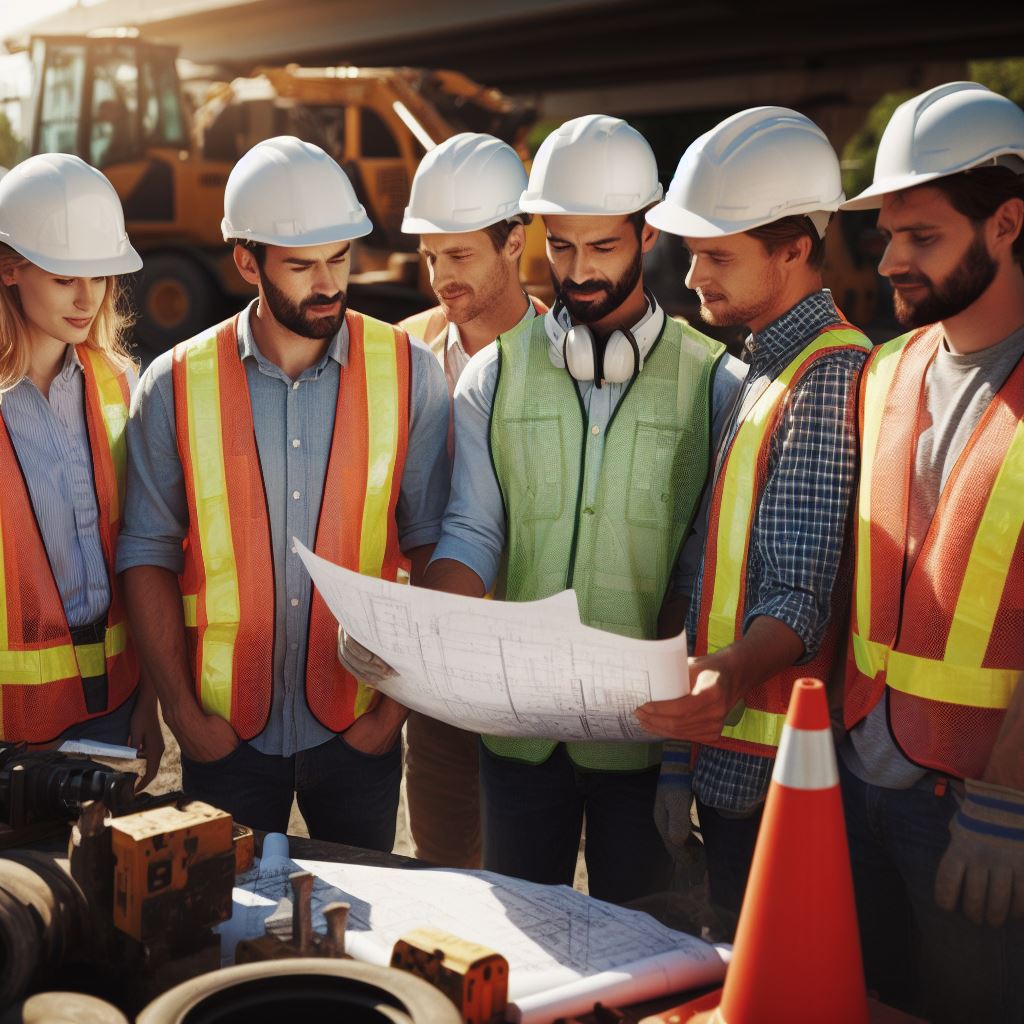Introduction
Civil engineers play a pivotal role in responding to and preparing for natural disasters.
Recent events, such as Hurricane Katrina and the California wildfires, underscore the urgent need for effective response and preparedness.
This blog post aims to explore the critical role of civil engineers in disaster management, highlighting their contribution to safeguarding communities and infrastructure in the face of natural calamities.
We will delve into the strategies, innovations, and best practices that civil engineers employ to mitigate the impact of disasters and bolster resilience.
By examining their proactive and responsive efforts, we can better understand how these professionals are at the forefront of disaster management in the United States.
Understanding the Role of Civil Engineers in Natural Disasters
Natural disasters can cause massive destruction and devastation, disrupting communities and leaving lasting impacts.
Civil engineers play a crucial role in responding to these events and minimizing the damage.
Let’s explore the specific tasks and responsibilities of civil engineers during natural disasters, the importance of their expertise in infrastructure assessment, restoration, and reinforcement, and some examples of civil engineering projects that have helped mitigate the impact of natural disasters.
Tasks and Responsibilities of Civil Engineers During Natural Disasters
1. Conducting Damage Assessments
- Civil engineers must assess the extent of the damage caused by the disaster.
- They evaluate the stability of structures, including buildings, bridges, and roadways.
- By identifying structural weaknesses, they can determine risks and prioritize rescue efforts.
2. Developing Emergency Response Plans
- Civil engineers contribute to the creation of emergency response plans for natural disasters.
- They collaborate with government agencies and emergency management teams to devise effective strategies.
- These plans include evacuation routes, shelter locations, and coordination of resources for efficient response and recovery.
3. Ensuring Public Safety
- Civil engineers focus on public safety during and after natural disasters.
- They inspect damaged structures and recommend whether they can be occupied safely.
- Engineers also assess the stability of slopes and embankments to prevent landslides and avalanches.
Importance of Civil Engineers in Infrastructure Assessment, Restoration, and Reinforcement
1. Infrastructure Assessment
- Civil engineers assess infrastructure damage to determine its safety and functionality.
- They inspect and analyze utility systems, including water, power, and communication networks.
- Accurate assessments assist in prioritizing repair efforts and allocating resources effectively.
2. Restoration Infrastructure
- Civil engineers oversee the repair and restoration of damaged infrastructure.
- They collaborate with construction crews and other professionals to ensure efficient reconstruction.
- The expertise of civil engineers is vital in restoring critical infrastructure like roads, bridges, and buildings, enabling normalcy to return swiftly.
3. Infrastructure Reinforcement
- Civil engineers play a pivotal role in reinforcing infrastructure to withstand future disasters.
- They apply knowledge of structural design and geotechnical engineering to make structures more resilient.
- Engineers incorporate features like earthquake-resistant designs, flood mitigation measures, and improved drainage systems.
Examples of Civil Engineering Projects Mitigating Natural Disasters
1. Seawalls and Breakwaters
- Civil engineers design and construct seawalls and breakwaters to protect coastal communities from the impacts of hurricanes and tsunamis.
- These structures dissipate wave energy and reduce coastal erosion, safeguarding lives and property.
2. Earthquake-Resistant Buildings
- Civil engineers incorporate seismic design principles to construct buildings capable of withstanding earthquake forces.
- Techniques such as base isolation and structural damping help minimize damage and protect occupants.
3. Flood Control Systems
- Civil engineers develop flood control systems, including levees, floodwalls, and retention ponds.
- These systems reduce the risk of flooding, protecting communities and preventing property damage.
In fact, civil engineers play a vital role in mitigating the impact of natural disasters.
Their involvement in tasks such as damage assessments, emergency planning, and ensuring public safety is crucial.
Moreover, their expertise in infrastructure assessment, restoration, and reinforcement is invaluable for minimizing the damage caused by natural disasters.
Through innovative projects and designs, civil engineers continuously strive to make our communities more resilient and better prepared to face future calamities.
Read: Navigating the Job Market: US Software Engineer Edition
US Response to Natural Disasters
Natural disasters such as hurricanes, earthquakes, and floods can cause widespread devastation, and the United States plays a key role in responding to and preparing for these events.
Several government agencies and organizations work together to ensure an effective response and collaboration in disaster response efforts.
Key Government Agencies and Organizations
When it comes to disaster response, various entities are involved in addressing the immediate needs of affected communities and facilitating long-term recovery.
Some of the key government agencies and organizations in the US response to natural disasters include:
- Federal Emergency Management Agency (FEMA): FEMA is a crucial agency responsible for coordinating and supporting the nation’s disaster response efforts.
- National Oceanic and Atmospheric Administration (NOAA): NOAA provides critical weather forecasts and warnings, helping communities prepare and respond to natural disasters.
- U.S. Geological Survey (USGS): USGS monitors earthquakes, collects data, and conducts research to mitigate the impacts of earthquakes and tsunamis.
- U.S. Army Corps of Engineers (USACE): USACE plays a vital role in disaster response by providing technical expertise in infrastructure assessment, reconstruction, and managing flood control systems.
Coordination and Collaboration
Effective disaster response requires close coordination and collaboration between different government agencies and organizations.
By working together, these entities can pool their resources and expertise to maximize the impact of their response efforts.
Coordination is facilitated through the National Response Framework, which outlines the roles and responsibilities of various entities in disaster response.
For example, FEMA works closely with state, local, tribal, and territorial governments to develop disaster response plans and ensure effective coordination at all levels.
The agency also collaborates with NGOs, private sector partners, and volunteer organizations to leverage additional resources and support for affected communities.
Notable Success Stories and the Role of Civil Engineers
Over the years, the United States has had significant success stories in responding to natural disasters.
These success stories were made possible through the contributions of various stakeholders, including civil engineers who play a crucial role in disaster response and recovery.
Civil engineers are responsible for designing and constructing resilient infrastructure that can withstand the impacts of natural disasters.
One notable success story is the reconstruction of the Gulf Coast after Hurricane Katrina in 2005.
Civil engineers played a key role in rebuilding critical infrastructure such as levees, flood walls, and pump stations.
Their expertise ensured that the region was better prepared to handle future hurricanes and flooding events.
Another example is the response to the devastating earthquake that struck Haiti in 2010.
Civil engineers were instrumental in assessing the structural integrity of buildings, designing temporary shelters, and helping with the reconstruction efforts.
Their expertise and knowledge of seismic design significantly contributed to the recovery of affected communities
In short, the United States has a comprehensive system in place to respond to and prepare for natural disasters.
Through the coordination and collaboration of various government agencies, organizations, and civil engineers, the nation is better equipped to mitigate the impacts of these events and ensure the resilience of affected communities.
Read: Top US Universities for Budding Software Engineers

Gain More Insights: How Automation is Changing the DBA Profession
Find Out More: Role of Chemical Engineers in Environmental Solutions
Preparedness Measures Implemented by Civil Engineers
1. The Importance of Proactive Preparedness Measures
Civil engineers play a crucial role in reducing the impact of natural disasters by implementing proactive preparedness measures.
These measures aim to minimize damage, save lives, and ensure the resilience of infrastructure.
2. Steps Taken by Civil Engineers in Assessing Vulnerabilities
Civil engineers conduct comprehensive assessments of vulnerabilities to understand the potential risks posed by natural disasters.
They evaluate the existing infrastructure, identify weaknesses, and determine areas that require attention.
3. Resilient Infrastructure
Civil engineers design infrastructure that can withstand the forces exerted by natural disasters.
They integrate resilience into the projects by considering factors such as seismic activity, flood zones, and wind loads.
4. Mitigation Strategies
Mitigation strategies form an integral part of preparedness measures.
Civil engineers develop strategies to minimize the impact of natural disasters on buildings, bridges, and other infrastructure.
These strategies include reinforcing structures, implementing early warning systems, and promoting evacuation plans.
5. Examples of Preparedness Initiatives in the US
- Retrofitting existing structures: Civil engineers in the US often retrofit buildings and bridges to improve their resilience against earthquakes and other natural hazards.
They reinforce foundations, install dampers, and upgrade structural components to enhance safety. - Constructing flood barriers and levees: In flood-prone areas, civil engineers build barriers like levees and flood walls to protect communities from devastating floods.
These structures redirect or contain floodwaters, reducing damage to homes and infrastructure. - Implementing hurricane-resistant designs: Along the coastlines, civil engineers incorporate hurricane-resistant designs in buildings and infrastructure.
This includes using impact-resistant windows, reinforced roofs, and designing structures to withstand high wind loads. - Installing early warning systems: Civil engineers deploy early warning systems to detect and provide timely alerts for seismic activities, tsunamis, hurricanes, and other disasters.
These systems enable prompt evacuation and save lives. - Developing resilient transportation networks: Civil engineers design roads, bridges, and transportation systems with resilience in mind.
They consider factors like drainage systems, slope stability, and the use of durable materials to ensure the continuity of transportation during and after natural disasters. - Promoting community preparedness: Civil engineers work closely with communities to raise awareness about disaster preparedness.
They engage in educational campaigns, training programs, and emergency drills to empower individuals to respond effectively during crises. - Designing sustainable infrastructure: In addition to natural disaster resilience, civil engineers focus on sustainability.
They incorporate green infrastructure, such as rain gardens and permeable pavements, to manage stormwater and reduce the strain on traditional drainage systems.
In essence, civil engineers play a vital role in implementing proactive preparedness measures to reduce the impact of natural disasters.
The examples provided demonstrate the wide range of preparedness initiatives undertaken by civil engineers in the US to safeguard communities from the devastating effects of natural disasters.
Read: Tech Stacks in Demand: US Software Job Market 2024
Delve into the Subject: Radiologic Technologist: Career Path and Growth
Current Challenges and Future Outlook
Current Challenges Faced by Civil Engineers in Responding to and Preparing for Natural Disasters
- Lack of Adequate Funding: Civil engineers face the challenge of limited financial resources to effectively respond to and prepare for natural disasters.
This hampers their ability to develop robust infrastructure and technologies to mitigate the impact of disasters. - Limited Awareness and Education: Many communities are unaware of the importance of civil engineering in disaster response and preparedness.
This lack of awareness hinders collaboration between engineers and communities in developing effective disaster management strategies. - Complex and Dynamic Nature of Disasters: Natural disasters are multifaceted and constantly evolving, presenting challenges for civil engineers who must anticipate and respond to various scenarios.
Each disaster requires a unique approach and requires engineers to think on their feet. - Inadequate Regulations and Building Codes: In some areas, regulations and building codes may not be stringent enough to withstand the intensity of natural disasters.
This puts lives and infrastructure at risk, making it crucial for civil engineers to advocate for stricter regulations. - Limited Integration of Technology: Although technology has advanced significantly, it is not always effectively integrated into disaster response and preparedness efforts.
Civil engineers face the challenge of harnessing the full potential of emerging technologies in their work.
Emerging Technologies and Approaches Enhancing the Effectiveness of Civil Engineering in Disaster Response
- Remote Sensing and GIS: Remote sensing technologies and Geographic Information System (GIS) mapping provide valuable data on disaster-prone areas.
Civil engineers can use these tools to identify vulnerable locations and develop appropriate strategies for disaster mitigation. - Building Information Modeling (BIM): BIM enables civil engineers to create virtual models of infrastructure projects, allowing for accurate simulations and identification of potential weaknesses.
This technology enhances the efficiency of design and construction processes, ensuring safer structures. - Advanced Early Warning Systems: Technological advancements have led to the development of sophisticated early warning systems that provide real-time alerts about impending disasters.
Civil engineers can utilize these systems to evacuate people and minimize casualties. - Resilient Infrastructure Designs: Civil engineers are increasingly incorporating resilient design principles, which focus on constructing infrastructure that can withstand the impact of natural disasters.
These designs include measures such as flexible foundations, flood-resistant materials, and earthquake-resistant structures.
Role of Civil Engineers in the Context of Climate Change and its Influence on Natural Disasters
- Climate Change Adaptation: As climate change intensifies, civil engineers play a crucial role in adapting infrastructure to withstand its effects.
They are involved in designing and implementing measures such as coastal protection systems, stormwater management, and flood control systems. - Sustainable Development: Civil engineers are at the forefront of promoting sustainable development practices.
They focus on reducing greenhouse gas emissions, incorporating renewable energy sources into infrastructure projects, and implementing efficient transportation systems to mitigate the impact of climate change. - Collaboration and Interdisciplinary Approach: To effectively address the challenges posed by climate change and natural disasters, civil engineers are increasingly collaborating with other disciplines.
This interdisciplinary approach allows for the integration of diverse expertise to develop innovative and sustainable solutions. - Advocacy and Policy Influence: Civil engineers have the responsibility to advocate for policies that prioritize disaster risk reduction and climate change adaptation.
They actively participate in shaping regulations, building codes, and infrastructure development guidelines to ensure resilience and sustainability.
In general, civil engineers face numerous challenges in responding to and preparing for natural disasters.
However, emerging technologies and approaches such as remote sensing, BIM, and advanced early warning systems enhance the effectiveness of civil engineering in disaster response.
Furthermore, the evolving role of civil engineers in climate change adaptation showcases their potential influence on minimizing the impact of future natural disasters.
Read: Evolution of Software Engineering in the US: A History
Transform Your Career Today
Unlock a personalized career strategy that drives real results. Get tailored advice and a roadmap designed just for you.
Start NowConclusion
Civil engineers play a crucial role in responding to and preparing for natural disasters.
Their expertise is essential in safeguarding communities and minimizing the impact of such calamities.
Ongoing investments in disaster response and preparedness initiatives are of utmost importance to ensure the safety and well-being of the population.
It is crucial that we appreciate and support the work of civil engineers in ensuring the resilience of our infrastructure in the face of natural disasters.
By working together, we can create a more disaster-resistant society and protect our communities from future devastation.




